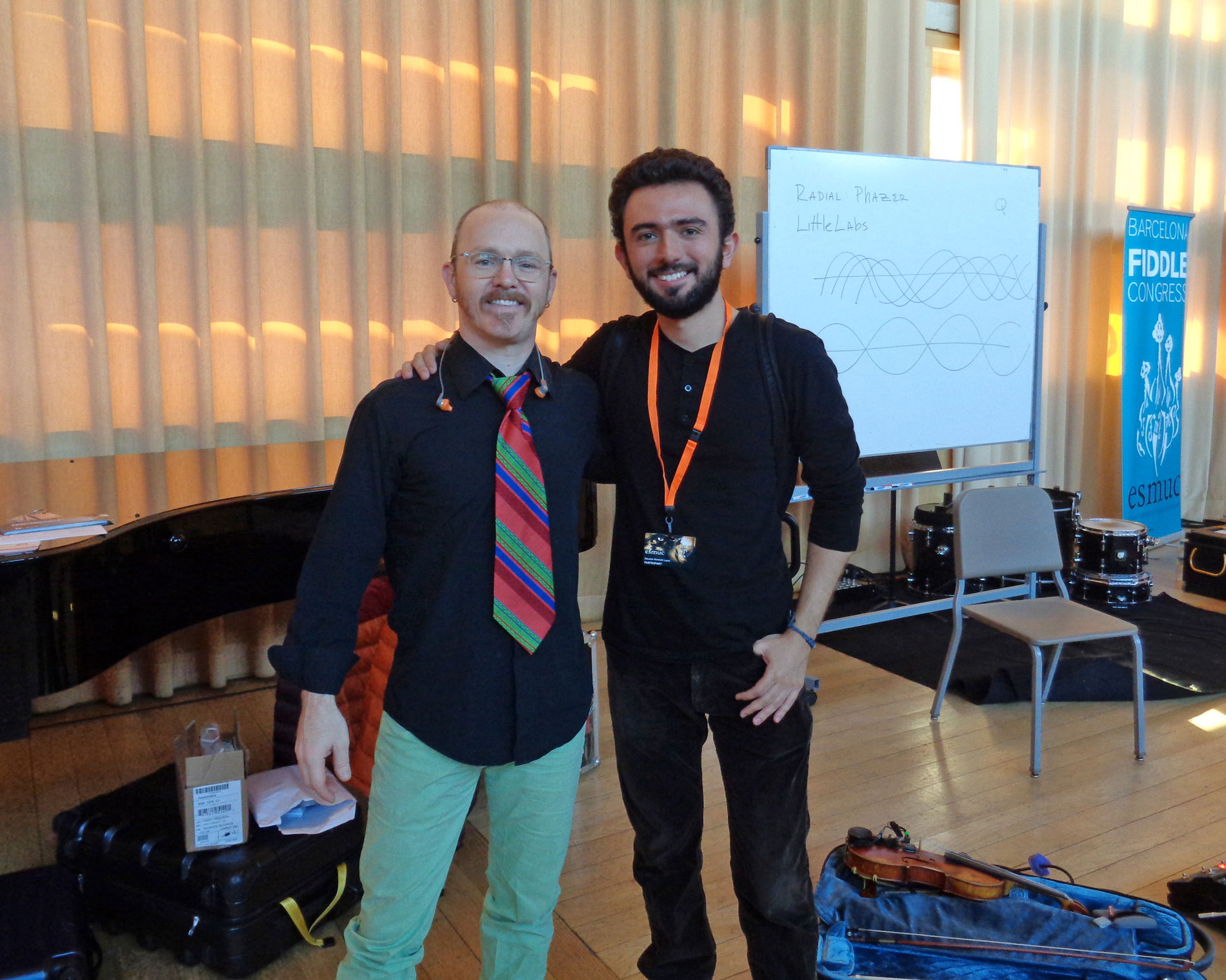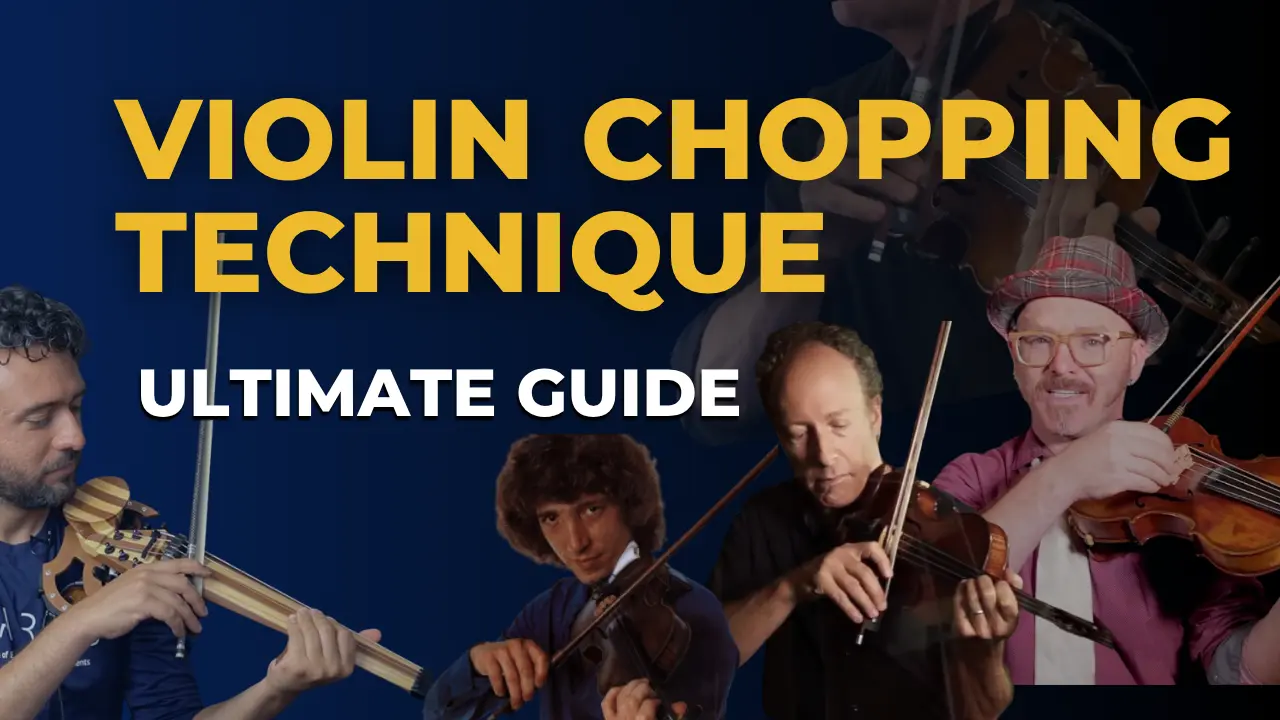Are you a string player tired of just playing the melody? Have you ever wished you could drive the rhythm section, turning your violin or cello into a complete groove machine? You’re in the right place. The “chop” is the revolutionary percussive bow technique that unlocked rhythmic playing for an entire generation of musicians. This is your ultimate guide to mastering it, from its hidden history to the exact mechanics you need to start today.
1. What is “The Chop”? Your Instrument as a Complete Rhythm Section
Imagine your violin, viola, or cello transforming from a purely melodic voice into the driving engine of a rhythm section. That is the revolutionary power of the “chop.” It’s a modern, percussive bow technique that allows a string player to create a full, grooving backbeat, effectively turning their instrument into a self-contained drum kit.
At its core, the chop is a “dry crunch” or “thwack” sound created by striking the strings with the bow hair near the frog. But its true genius lies in its rhythmic application. A skilled “chopper” can emulate a drum set by using the lower strings for deep, resonant kick drum sounds and the higher strings for sharp, crisp snare drum hits. This ability to lay down a complete groove has made the chop an essential tool for string players in virtually every contemporary genre.
2. The Definitive History: From a Bluegrass Accident to a Global Phenomenon
The chop’s story is a fascinating journey of innovation born from necessity, refined by collaboration, and codified by a new generation of virtuosos.
The Innovator: Richard Greene’s “Chunky Chop” (1966)
The chop was born on the stage with the “Father of Bluegrass,” Bill Monroe. Around 1966, Monroe instructed his young fiddler, Richard Greene, to stop playing melodic fills and instead provide a hard-driving rhythmic backup to mimic the mandolin’s percussive “chop.”
Traditional methods of marking the beat were exhausting. Playing at the tip tired the wrist, while playing at the frog tired the whole arm. As Greene tells it, out of sheer fatigue, he simply let his bow rest on the strings after a downward “chunk.” The magic happened when he lifted it. Instead of a clean lift, his tired arm produced a “lazy, scraping” upward motion.
This two-part motion created a revolutionary sound:
- The Chop: A vertical, percussive, pitchless “chunk.”
- The Pinch: A scraping, pitched sound on the release.
Greene called this rich, textured sound the “Chunky Chop,” and Bill Monroe loved it. An entire school of string playing was born from a moment of exhaustion and ingenuity.
Patient One: Darol Anger’s Refinement and Expansion
The next crucial figure is new acoustic music pioneer Darol Anger. After learning the technique directly from Greene in the 1970s, he became what he calls “Patient One.” Anger didn’t just copy the technique; he analyzed and expanded it. He refined the now-standard bow hold and explored parallel bow movements, vastly increasing its rhythmic vocabulary.
While the chop was an exciting solo device for Greene, Anger saw its potential as an ensemble tool. This vision was fully realized with his group, the Turtle Island String Quartet. Here, the chop became the rhythmic backbone, allowing a string quartet to deliver the powerful groove and swing of a full jazz band—complete with a rhythm section—without a drummer.
The Virtuoso: Casey Driessen’s Codification and the “Triple Chop”
The third generation is personified by Casey Driessen. A student of Anger’s, Driessen pushed the technique to its virtuosic limits. One day, his bow “skipped” across the strings in a unique way, leading to the birth of the advanced “Triple Chop”—a rapid, bounced triplet that adds incredible rhythmic density.
Driessen’s most lasting contribution, however, is formalizing the technique. Finding that existing notation couldn’t capture the new complexities, he collaborated with Spanish violinist Oriol Saña to create “The Chop Notation Project.” This comprehensive system provided a standardized written language for the chop, transforming it from a folk oral tradition into a formal discipline that could be taught, composed, and shared accurately worldwide.
3. Deconstructing the Chop: A Technical Deep Dive
Mastering the chop requires a fundamental shift in mindset and mechanics, often feeling like “unlearning” years of classical training. It’s about embracing a new ergonomic approach to unlock rhythmic potential.
The Ergonomics: “Unlearning” for Rhythmic Freedom
- Bow Hold: You can use a traditional hold or place the thumb under the frog, but consistency is key. The crucial adjustment is often straightening the thumb and relaxing the fingers. The 4th finger (pinky) remains essential for balance and control.
- Wrist Motion: The power comes from a loose, flexible wrist, not the arm. The movement is a vertical “wave” or “flick,” allowing the bow’s natural weight to do the work.
- Location on Bow: The chop lives exclusively at the frog (the first 2 inches / 5 cm of the bow). This is the balance point that provides the necessary weight and control for a crisp, percussive sound.
- Bow Angle: Unlike classical playing, a perfectly perpendicular bow is not required. A slight angle (tip towards you, frog away) can produce a richer, crunchier tone and a more relaxed posture.

The Core Mechanic: Understanding the “Chop and Pinch”
The fundamental sound of the chop, what Richard Greene called the “chunky chop,” is a two-part motion often verbalized as “Chack-Ka.”
- The “Chack” (The Chop): The bow drops vertically onto the strings and, crucially, stays there. This deadens the string and produces a sharp, pitchless percussive sound. The left hand often mutes the strings to ensure the sound is purely rhythmic.
- The “Ka” (The Pinch): From its resting position, the bow is lifted with a slight horizontal scrape (a “tiny up-bow”). This second motion produces a sound with a discernible pitch, providing the harmonic element of the groove.
The Chop Vocabulary: A Glossary of Sounds
Thanks to “The Chop Notation Project,” we have a standardized language for different chop strokes:
- Hard Chop: An accented down-bow strike using the full weight of the bow. This is your snare drum backbeat.
- Soft Chop: A lighter, unaccented vertical motion used for ghost notes and subdivisions. Think of these as the hi-hats keeping time.
- Ghost Notes: Fingered notes in the left hand played with a soft chop, creating a subtle melodic and rhythmic texture.
- Scrapes: A “third move” beyond the binary up/down motion. The bow is dragged parallel or in a circle along the strings to create a scratchy, sustained sound, similar to a shaker or brushes.
- Triple Chop: A virtuosic, bounced scrape that produces a rapid triplet, adding a burst of rhythmic energy.
4. The Masters and Visionaries: Key Figures of the Chop
The Founding Trio: Greene, Anger, and Driessen
These three artists form the direct lineage of the chop: Richard Greene as the Innovator, Darol Anger as the Refiner and Disseminator, and Casey Driessen as the Virtuoso and Codifier. Their collective work defines the history and technique of modern chopping.
Expanding the Family: Rushad Eggleston and Mike Block on Cello
The chop quickly spread beyond the violin. Visionary cellist Rushad Eggleston, a founding member of the band Crooked Still, redefined the cello’s role in acoustic music. His energetic, chop-heavy style turned the instrument into the rhythmic core of the band, influencing a generation of cellists. Fellow cellist and educator Mike Block has been instrumental in creating a structured curriculum for teaching the chop on cello, making it accessible to students worldwide through platforms like ArtistWorks.
Parallel Innovations: Tracy Silverman and “Strum Bowing”
Another key figure in modern rhythmic string playing is Tracy Silverman, renowned for his work on the 6-string electric violin. He developed a comprehensive system called “Strum Bowing,” a parallel evolution that shares the chop’s philosophy of turning the bow into a rhythmic tool for strumming, grooves, and harmonic accompaniment.
Educators for the Spanish-Speaking World: Eduardo Bortolotti’s Role
The global spread of the chop relies on dedicated educators. In the Spanish-speaking community, violinist Eduardo Bortolotti has played a key role in making the technique accessible. His clear and engaging video tutorials break down both the history and the practical application of the chop for a new audience.
- To learn about the origins, watch: The History of the Chop, by Eduardo Bortolotti
- For a step-by-step guide to get started, see: How to Play Chop, by Eduardo Bortolotti
5. Beyond Bluegrass: How the Chop Conquered Jazz, Pop, Celtic, and More
The chop’s ability to translate the universal language of a drum backbeat onto a string instrument is the key to its widespread adoption.
- Jazz: The Turtle Island String Quartet proved that a string ensemble could generate an authentic swing feel without a drummer.
- Rock and Pop: The chop is now essential for string players accompanying singer-songwriters and for quartets performing energetic arrangements of popular music.
- Celtic Music: Innovators like Hanneke Cassel and Natalie Haas have masterfully integrated the chop into Celtic traditions, adding a fresh percussive layer to jigs and reels.
6. Your Guide to Learning the Chop: Essential Resources
The Foundational Text: “The Chop Notation Project”
The single most important resource for any serious student is Casey Driessen and Oriol Saña’s “The Chop Notation Project.” This free PDF is a comprehensive guide containing the history, detailed mechanics, a full notation glossary, and progressive exercises.
Online Courses and Communities
- Darol Anger and Mike Block offer in-depth courses on ArtistWorks, covering everything from Bluegrass fiddle to multi-style cello.
- Casey Driessen offers video workshops on his personal website, caseydriessen.com.
- The “World Of Chop” Facebook group is a vibrant community where players share ideas, videos, and encouragement.
7. Chop vs. Other Percussive Techniques: A Comparative Analysis
It’s vital to distinguish the chop from other string effects. They are not interchangeable; each serves a different musical purpose.
| Feature | Chop | Col Legno Battuto | Bartók Pizzicato |
|---|---|---|---|
| Part Used | Bow hair (at the frog) | Wood of the bow | Fingers of the hand |
| Mechanism | Vertical drop + horizontal scrape | Striking with the wood | A violent pluck causing the string to snap against the fingerboard |
| Sound Quality | “Crunchy,” bi-phonic (percussive attack + pitched release) | Dry, woody, faint pitch | Sharp, aggressive “snap” with a clear pitch |
| Primary Function | To create a sustained groove | A textural, coloristic effect | A dramatic, violent accent |
In short, Col Legno is for color and Bartók Pizz is for drama. The Chop is for groove.
8. Frequently Asked Questions (FAQ) About the Chop
Is the chop difficult to learn?
The biggest challenge is often mental—it requires relaxing and “unlearning” rigid classical habits. With focused, patient practice on wrist flexibility, it is very achievable.
Will chopping damage my bow hair?
No. When performed correctly at the frog, the technique uses the bow’s natural weight, not damaging force. It does not cause unusual wear and tear on the hair.
Do I need a special instrument or bow?
Not at all. The chop can be performed on any standard violin, viola, cello, or double bass with a standard bow.
Who invented the violin chop?
Fiddler Richard Greene is universally credited with inventing the technique around 1966 while he was a member of Bill Monroe’s Bluegrass Boys.
9. Conclusion: The Future of Rhythm is in Your Hands
The chop has evolved from a clever solution to a physical problem into an indispensable part of the modern string player’s vocabulary. It has fundamentally changed the role of string instruments in contemporary music, empowering players to move from the melodic periphery to the rhythmic core.
With its ongoing integration with technology like MIDI triggers and live looping, the future of the chop promises even greater sonic exploration. What began as a “chunky chop” in a bluegrass band has given bowed string instruments a powerful new voice—one that not only sings, but also drives the beat.
